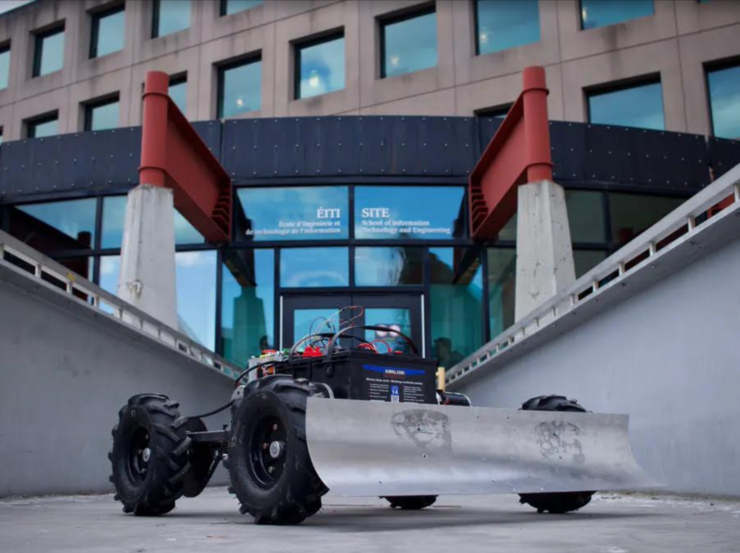UNIVERSITY OF OTTAWA STUDENTS ENTER AUTONOMOUS SNOWPLOW COMPETITIONS
A team of engineering students from the University of Ottawa are putting their self-driving snowplow design into competitive action.
The Canadian Automated Snow Plow Initiative and the Annual Autonomous Snowplow Competition will take place in the spring of 2021. For these competitions, each team must design and build a snowplow that can autonomously clear snow from a pre-selected path.
Nicholas Schmidt, a third-year mechanical engineering and computing technology student at the U of O, was inspired to launch this project when he heard about these competitions.
“This project seemed like a really inspiring and relevant thing to do as a Canadian and I was surprised, because it didn’t seem like anyone in Ottawa was currently working on a project like this,” said Schmidt. “So, I thought it would be fantastic to pursue this challenge.”
It wasn’t long before five other engineering students — Samarth Saxena, Ben McLean, Zohaib Ali, Loïc Darboux, Kurian George Binu, and Greg Price — joined the project.
“I’m learning a lot and I also get to help the community,” said Saxena, a third-year computer engineering student at the U of O. “On top of this, I also have the chance to participate in the competitions — overall, this is a great learning opportunity.”
How the autonomous snowplow works
This autonomous snowplow comprises three systems: mechanical, electronic, and software.
The mechanical and electrical system resembles a robotic snowplow that includes a basic metal frame and snow tires, and it is powered by a marine battery. However, the plow’s electronics and software are what give the plow its unique autonomous abilities.
“We installed a real-time kinematic global positioning system on the plow so that we can get accurate readings on its placements,” Schmidt said. “Also, to detect obstacles, the plow relies on its cameras.”
A real-time kinematic global positioning system, or RTK-GPS, is a tool that allows for high precision navigation.
“The plow’s system relies on a base station to relay [accurate route] corrections between one to three centimetres,” Schmidt said.
The team trained their plow to respond to obstructions to further enhance precise navigation and to memorize a set of 200 images so that it can determine whether a path is obstructed or not.
“You can compare our plow to the way a Tesla works,” said McLean, a fourth-year mechanical engineering student at the U of O.
“The driver puts in where they want to go in the Tesla’s GPS and then the car relies on its cameras to make corrections to the route along the way. This is basically how our plow works.”
Like the Tesla, the plow can choose to keep its original path or, if the way is blocked, it can produce a new path with its RTK-GPS.
The team successfully developed software that allows the plow to drive free of human intervention. They continue to make improvements in preparation for the spring, which is their competition season.
The future of autonomous snowplows in Canada
The team sees a bright future for autonomous snow plows in Canada. Schmidt believes that this technology can simplify snow management.
“The motivation behind this project is to make peoples’ lives a little bit better and save them time,” said Schmidt.
McLean believes that when the autonomous plows become widely available, shovelling-related injuries in Canada will subside.
“Shovelling snow is physically demanding and it often leads to back injuries. I think automated snowplows could [reduce these physical stresses],” McLean said.
The Canadian Centre for Occupational Health and Safety says that people who regularly shovel snow can acquire back injuries if they do not lift the shovel with their knees, which is a proper shovelling technique.
Further, according to a 2017 study published in the Canadian Medical Association Journal, men who regularly shovel snow are at greater risk for heart attacks after large snowfalls due to the sudden increase of stress placed on their bodies
So, for public health reasons alone, the U of O snow plow team believes this product can be a life saver.
“It will take some time to refine our project and make it a viable consumer product,” said Schmidt. “But we have spoken to many community members in Ottawa who are interested in this project.”
“Also, it would be cool to [one day] have a snowplow deploy from my garage after a snowstorm while I stay inside by the warm fire.”





